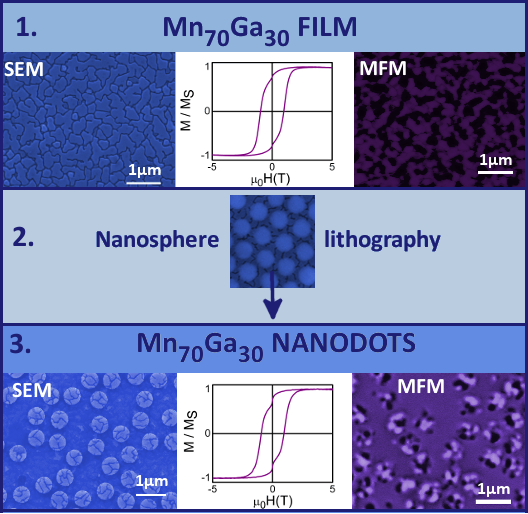Significance Statement
Metastable tetragonal D022 phase of manganese-gallium exhibits unique attributes that can be exploited for a number of spintronic device applications. The material shows low saturation magnetization owing to the ferrimagnetic alignment of manganese on two inequivalent sub-lattices in the structure; the magnetization can be changed by altering the manganese content. Above all, it has low Gilbert damping, huge uniaxial magnetic anisotropy, spin polarization, and high Curie temperature. These material properties make it important for spin torque driven memories and devices including spin transfer torque MRAMs as well as spin transfer oscillators.
Both spin transfer torque MRAMs and spin transfer oscillators necessitate nano-structuring of the material used. Therefore, several fabrication studies have been done concerning many magnetic materials including D022 manganese-gallium. However, there are problems still outstanding. Studies of D022 manganese-gallium nanostructures where the nanostructures resulted from a 3D growth mode of the material led to multiphase particles or irregularly shaped particles were obtained.
Typical optical and sequential nano-lithographic methods have been used to generate a high degree of patterning regularity in a low area. However, these methods incur high costs when implemented in an industrial environment. Self-assembly of polymeric nano-spheres have been identified recently as an alternative to typical nano-lithographic processes. The method allows for easy patterning of a wide region. In order to obtain a high degree of hexagonal close packing in the course of self-assembly, a functionalization of the surface of the nano-spheres is an important fabrication parameter.
In a recent paper published in Applied Surface Science Julie Karel and co-workers presented nano-lithographic patterning of the manganese-gallium D022 phase by self-assembly of polystyrene nano-spheres. The method was inexpensive with the capacity to pattern large areas; therefore, it is attractive for prospective device fabrication.
The authors prepared manganese-gallium thin films through RF sputtering. The film was grown on a single crystal strontium titanate substrate at 300°C. They then deposited a 5nm platinum capping layer to curtail oxidation. Nano-structuring was then done implementing a self-assembled nanolithography procedure.
After the process of nano-structuring, annealing temperatures below 200°C were used to enhance the properties of the nanostructured samples. The authors performed characterization using X-ray diffraction and scanning electron microscopy.
The authors observed nanodots, which had similar features as the parent film, i.e. large coercivity and perpendicular magnetic anisotropy. They observed a kink in the magnetic hysteresis loop in the nanostructured material and referenced it to chemical disorder of the D022 phase induced in the course of the lithographic process.
The chemical order was recovered in the nanostructures after low temperature annealing. The nanodots posted several magnetic domains owing to their size, thus future research will include reducing the size of the nanostructures.
The results presented in their paper demonstrate that the nano-sphere lithography is a potential method for effectively preparing magnetic nanostructures with the magnetization oriented perpendicular to the substrate surface. Future research will constitute reducing the size of the nanodot and obtaining single domain nanodots, which will make this approach relevant for the fabrication of spintronic devices such as spin transfer oscillators and spin transfer torque MRAMs.

Reference
Karel, F. Casoli, P. Lupo, F. Celegato, R. Sahoo, B. Ernst, P. Tiberto, F. Albertini, C. Felser. MnxGa1−x nanodots with high coercivity and perpendicular magnetic anisotropy. Applied Surface Science, volume 387 (2016), pages 1169–1173.
Go To Applied Surface Science Advances in Engineering Advances in Engineering features breaking research judged by Advances in Engineering advisory team to be of key importance in the Engineering field. Papers are selected from over 10,000 published each week from most peer reviewed journals.
Advances in Engineering Advances in Engineering features breaking research judged by Advances in Engineering advisory team to be of key importance in the Engineering field. Papers are selected from over 10,000 published each week from most peer reviewed journals.









